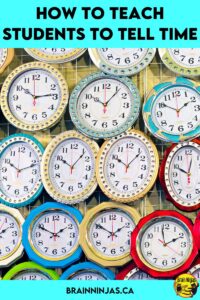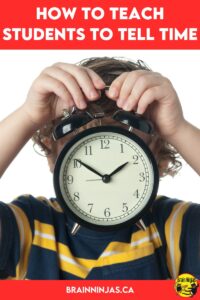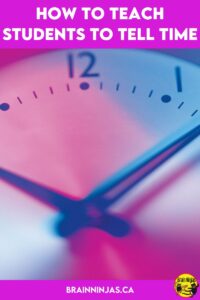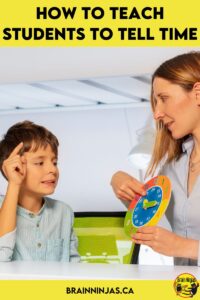
Teaching students to tell time is a necessary and difficult challenge, but time lessons are a life skill.
Some people argue that reading analog clocks is a skill that is slowly disappearing. Perhaps one day, digital clocks will completely take over, but for now, they are still around, causing grief for teachers and students around the world during time lessons in math class.
Come learn some of the activities we use to help our students learn to read the time with these time lessons that will save you time.
Teach Students to Read Time
One of the best places to start with teaching time lessons is to find out where your students are and what they already know. We use a few Time Concepts Worksheets to talk about time without the pressure of reading clocks. Find these worksheets in our TpT Store ($USD) or our BN Shop ($CAN).
Explicit Teaching

This seems like a given, but students need to be taught how to read time explicitly as well as see how it connects to their lives in organic ways. One approach to time lessons is through interactive notebooks. Our notebooks work through specific math concepts, helping students create a resource page they can refer to as they work through the unit.
Time lessons are part of our Time and Measurement Interactive Unit for Grade 3. This version includes time concepts, reading a clock (am/pm, 12/24 hour, English/French time), and reading a calendar. You can find this unit on TpT ($USD) or our BN Shop ($CAN).
The Grade 4 Reading Clocks and Elapsed Time Interactive Unit includes reading a calendar and writing dates, 12/24-hour clocks and AM/PM, telling time in hours, half and quarter hours, and minutes, and elapsed time. You can find this unit on TpT ($USD) or our BN Shop ($CAN).
Our Grade 4/5 Telling Time and Elapsed Time Interactive Unit includes reading clocks, am/pm time, 24-hour clocks, and elapsed time. Find it on TpT ($USD) or our BN Shop ($CAN).
The Grade 5 Calculating Elapsed Time Interactive Unit includes elapsed time and calculating the duration of time. You can find this unit on TpT ($USD) or our BN Shop ($CAN).
If you can get your hands on a set of Judy Clocks or any clock faces where students can practice, it’s easier at first than drawing clocks.
Practice
We let students practice different time concepts regularly. We have listed the specific outcomes within the different sections below, but if you’re looking for all the sets at once, you can find them here.
Worksheet bundles are available at a discount. Learn some of the ways we use worksheets in our classroom in our post: Math Worksheets Games Your Students Will Love.
Grade 3 Worksheet Bundle in our TpT Store ($USD) or our BN Shop ($CAN).
Grade 4 Worksheet Bundle in our TpT Store ($USD) or our BN Shop ($CAN).
Grade 5 Worksheet Bundle in our TpT Store ($USD) or our BN Shop ($CAN).
Our aligned worksheet bundles are specifically designed for each province’s curriculum.
Alberta Aligned Time and Measurement Worksheet Bundle in our TpT Store ($USD) or BN Shop ($CAN).
British Columbia Aligned Time and Measurement Worksheet Bundle in our TpT Store ($USD) or BN Shop ($CAN).
Saskatchewan Aligned Time and Measurement Worksheet Bundle in our TpT Store ($USD) or BN Shop ($CAN).
Task card bundles are available at a discount. Learn some of the ways we use task cards in our classroom in our post: The Trouble With Task Cards and How to Fix It. Find our Task Cards Bundle in our TpT Store ($USD) or BN Shop ($CAN).
Make Mistakes
One of the ways we assess whether or not students can read clocks is to intentionally give them a completed worksheet full of errors to let them find them. Use this error analysis activity to get started and then replace them with any completed worksheet. You can find our Error Analysis Activity in our Resource Library. If you’re not already a ninja, we can send it directly to your inbox.
Days, Months, Years
Young students tend to learn how to read calendars during circle time. They learn songs and rhymes to remember the days of the week and months of the year. Students discuss the seasons in broad terms all through the year. These time lessons are integrated into their daily routines.
When students get older, we tend to leave out circle time. This means students lose out on the valuable review of time lessons throughout the school year. You can easily add reading the calendar back into your upper elementary morning routine just by discussing and demonstrating different ways to write the date each day. This can help students learn the numbers used to represent the months and learn how many days each month has.
Have students create a simple anchor chart to show the number of seconds in a minute, minutes in an hour, hours in a day, days in a week, or weeks in a month/year.
If you are looking for calendar worksheets, we have a set for Calendar and Dates: Reading and Writing in our TpT Store ($USD) or BN Shop ($CAN). We also have a Calendar and Dates: Variety of Formats Worksheet set in our TpT Store ($USD) or BN Shop ($CAN).
Understanding AM and PM and the 12 Hour Clock
In our classroom, we have a standard school clock. It’s analog and uses the twelve hour system. We also have several digital clocks around the room. Our computer displays are in twelve hour time. As we move through the day, we point out the time on all the clocks and talk about AM and PM. Students begin to understand the different times of the day. They know that their gym class is on Mondays in the afternoon because it’s 2:30 PM.
Teach students that the twelve hour clock has an AM (Ante Meridian) and PM (Post Meridian). There are 24 hours in each day, so two twelve hour parts make up the whole day. We show students this visually by making a grid or table with six squares across and four squares down. We shade the top half of the grid with one colour and the bottom half with another. Then, we write 1-12 on the top twelve squares and 1-12 on the bottom twelve.
| 1 | 2 | 3 | 4 | 5 | 6 |
| 7 | 8 | 9 | 10 | 11 | 12 |
| 1 | 2 | 3 | 4 | 5 | 6 |
| 7 | 8 | 9 | 10 | 11 | 12 |
AM/PM and 12/24 Hours Worksheets in our TpT Store ($USD) or BN Shop ($CAN).
The 24 Hour Clock

In theory, the 24-hour clock should be easier because students just have to count up to twenty-four to use it. However, since the majority of places in Canada don’t use 24-hour time (except in Quebec), students don’t get exposed to it as often as they should. We use 24-hour clocks in our classroom so students can start to see patterns.
We make the same chart as listed above, but instead of counting to twelve, we just count the numbers up to 24. Students generally understand that a day has twenty-four hours, but start to get mixed up when they have to change between twelve and twenty-four times. Change your digital clocks to 24-hour time, so students see them regularly.
This is where understanding AM and PM comes in.
AM/PM 12/24 Hours Worksheets in our TpT Store ($USD) or BN Shop ($CAN). This set is also listed above under AM/PM.
More AM/PM 12/24 Hours Worksheets in our TpT Store ($USD) or BN Shop ($CAN).
12 and 24-Hour Clocks Task Cards in our TpT Store ($USD) or BN Shop ($CAN). These include AM/PM time.
Reading Analog Clocks to the Hour
Teach It
Generally, students have difficulty with clocks because they use Base 60 instead of Base 10. Show students that 60 seconds equals one minute, and 60 minutes equals one hour.
Explain the different parts of a clock, including the face and hands. The shorter hand represents the hour. Point out that the word HOUR is shorter than the word MINUTE. The longer hand is the minute hand.
Play a Game

The numbers on twelve-hour clocks represent the hour. Students often wonder why the twelve is at the top. Play a simple game. Line up students against the wall. Explain that they will count their steps as they step forward. When they count a few steps, ask them which number was first. They should say “one.” Ask students why they didn’t start with “zero.” It’s because you don’t start counting with zero.
This time, have them count their steps in unison as you point to the large numbers on the clock. They start with zero and the first number is one until they get to twelve. Since clocks don’t really have room to place a twelve and a zero at the top of the clock, clockmakers removed the zero and left it as a twelve.
Now, have students do the same activity, but this time, they are going to count to 24 to represent the 24-hour clock. They should notice that you have to count around the clock twice. For the second half, all the numbers on the clock don’t match. To get the correct number, you would have to add twelve to each of the numbers.
Mark out twelve spots on the floor in a circle (scrap paper or hula hoops work). Have students walk about the circle, counting out the hours with twelve. When they have that down, have students go around twice up to twenty-four.
Make an Anchor Chart
Make an anchor chart with students to show the twelve and twenty-four numbers (we use different colours). Get your students to make the chart. It will encourage them to think through the chart as they build it and they are more likely to refer to it after.
Quarter and Half Hours
Showing students how to divide the clock face into four sections is the easiest and most visual way to show students how the clock is divided into quarters. Connect this to fractions.
Reading Clocks Worksheets in our TpT Store ($USD) or BN Shop ($CAN).
More Reading Clocks Worksheets in our TpT Store ($USD) or BN Shop ($CAN).
Telling Time to Five Minute Intervals
Counting by five is generally easy for most students, so use that to show students how to count the minutes on the clock. We cover the numbers on our giant clock with sticky notes. Place a large dot on the note covering the twelve. Remind students to always start counting by five from the top of the clock (where the 12 is found). Covering the clock numbers helps students focus on counting by five instead of being confused by the numbers on the clock face (which don’t make sense for students until they understand the hours).
Reading Clocks Worksheets in our TpT Store ($USD) or BN Shop ($CAN).
More Reading Clocks Worksheets in our TpT Store ($USD) or BN Shop ($CAN).
Reading to the Minute
Many clocks include little ticks between the five minute intervals, so point these out to students. Explain that one way to find the minutes is to count all the little ticks (but that’s not always practical). That is why it is important to learn to count by five around the clock and then add the few minutes left over to get the total.
Reading Clocks Worksheets in our TpT Store ($USD) or BN Shop ($CAN).
More Reading Clocks Worksheets in our TpT Store ($USD) or BN Shop ($CAN).
Telling Time (Reading Clocks) Task Cards in our TpT Store ($USD) or BN Shop ($CAN).
To and After
Sometimes, the minutes to an hour or the minutes after an hour cause the most problems. There are plenty of ways to say some of the numbers, and depending on where you live in the world, there are ways you might not even know about.
Saying half past one, one thirty and half one all mean the same thing in British countries. However, half one in Germany means twelve-thirty, so it’s no wonder telling time can be a challenge for students.
Our advice is to focus first on writing analog clock times as digital time in both twelve and twenty-four hour time. Then, as students become comfortable, explore all the possible ways to say the times.
Elapsed Time
Students cannot calculate elapsed time until they have a solid understanding of telling time and the different units.
Asking simple questions can help students begin to understand elapsed time using the calendar. How many days until our math test? How many days did we work on this science unit? Show students the school calendar and have them calculate the number of days since events or until upcoming events.
Number lines are one of the easiest and most visual ways we show students how to calculate the time that has passed. We made our own by taking some Ikea paper measuring tapes and cutting them each at 60cm (to represent Base 60) and then taped them together to make several hours. Then, we marked the quarter and half hours. We lined them up along the wall and marked the start of each new hour with a big dot. When students use the number line, the dot can represent any hour, and they can count hours or minutes on either side.

Elapsed Time Worksheets in our TpT Store ($USD) or BN Shop ($CAN). These include word problems.
Elapsed Time Task Cards in our TpT Store ($USD) or BN Shop ($CAN). This includes two decks on comparing elapsed time on clocks or using digital times and one deck of word problems.
What else are you teaching in math class?
Conquer Math With These Proven Multiplication Strategies
The Truth About New Math
How to Change Math With Interactive Notebooks
How to Use Interactive Notebooks to Teach Number Sense
Mastering the Angles: Innovative Approaches to Teaching Geometry Concepts
How to Teach Students to Analyze Errors in Math
How to Help Your Students Master Decimal Operations
Differentiate Your Math Lessons
How to Teach Successful Long Division Strategies
How to Make Teaching Patterns Painless
What other strategies do you use during your time lessons? We’d love to hear about them. Leave us a comment below.







